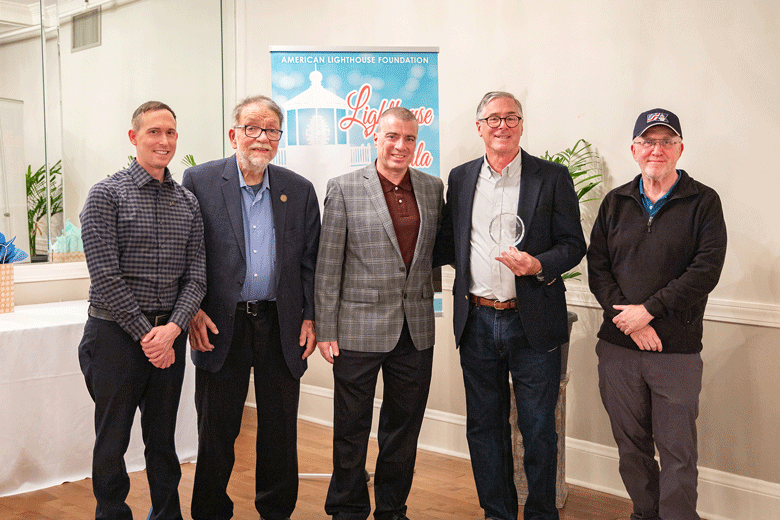The American Lighthouse Foundation recently presented Peter Ralston with its Keeper of the Light award during the organization’s year-end gala at the Nonantum Resort in Kennebunkport. Ralston was recognized for his efforts in helping create and guide the Maine Lights Program on the 25th anniversary of its successful completion in 1998.
In 1998, government entities and nonprofits obtaining one of 28 lighthouses being transferred through the Maine Lights Program gathered on the lawn of the Samoset Resort to receive ceremonial deeds from the commandant of the U.S. Coast Guard. Thanks to the visionary efforts of Ralston, who was working with Island Institute, the organization he co-founded, this unprecedented achievement still shines for many of Maine’s lighthouses today.
In April 1989, the former keeper’s house at Heron Neck Light Station on Greens Island, off Vinalhaven, suffered a fire that badly damaged the historic structure. The Coast Guard announced plans to demolish the structure.
Preservationists and community members alike opposed the plan and eventually the historic property was transferred to Island Institute in Rockland. Island Institute in turn partnered with private individuals who worked diligently to restore the fire-damaged keeper’s house in the years that followed.
The success of this project inspired Ralston, then the executive vice-president of Island Institute, to approach the Coast Guard with a proposal. “Why don’t we draft a piece of legislation that would effect a mass transfer of Maine’s lighthouses?,” Ralston asked. Such a groundbreaking idea—thought to be unfeasible when initially proposed, became the Maine Lights Program. The Maine Lights legislation was later approved as federal law on Oct. 19, 1996.
A 2020 story entitled, “Keeping the Lights On,” by former Island president Philip Conkling noted: “By 1994 the Institute and the Coast Guard had worked out a process for the expedited transfer of eligible Maine lighthouses to other agencies and groups in exchange for maintaining the structures and providing public access to the transferred properties.”
Conkling also noted: “Two years after the completion of the property transfers, Congress passed the National Historic Lighthouse Preservation Act. The act, modeled on the Maine Lights Program, established a national process for transferring any historic federal properties across the country to government agencies and private nonprofit groups.”
In part, what made the Maine Lights Program so vital to the well-being of Maine’s lighthouses was that the process sought to identify long-term preservation solutions for many of the state’s historic light stations located on islands.
“The initiative was like no other in lighthouse history,” said Bob Trapani, Jr., American Lighthouse Foundation executive director. “It was replete with opportunities for preservation, adaptive reuse, public access, and educational possibilities that were previously unattainable in both scope and impact. This was especially so for offshore lighthouses.”
Ralston credited local nonprofits and host communities with bring the idea to fruition.
“Although I conceived of what became the Maine Lights Program, not a single bit of it would—or could—have happened without the passion, commitment, hard work, and faith of a great many others who wanted to ensure that Maine will never lose its lighthouse heritage, much less the lighthouses themselves,” he said.
“The program initially bore fruit 30 years ago but what really counts is the sustained dedication—not to mention countless hours and dollars—expended since then. The lights of the Maine Lights Program burn brightly to this very day.”





